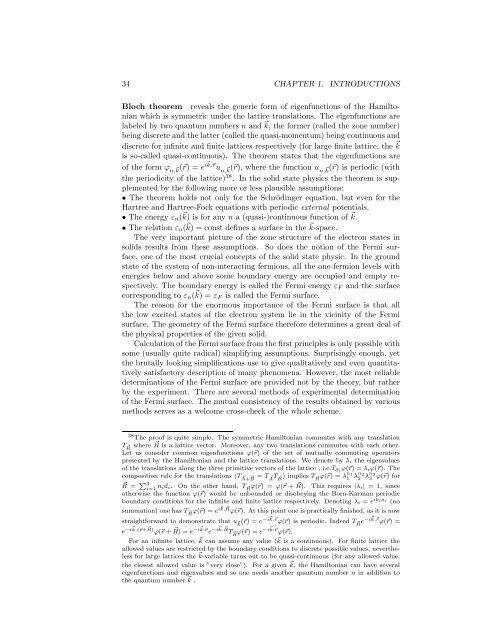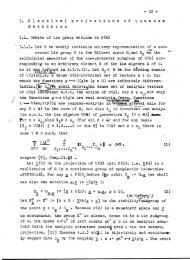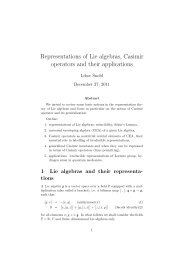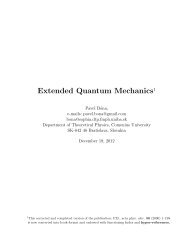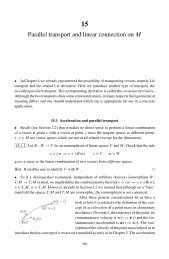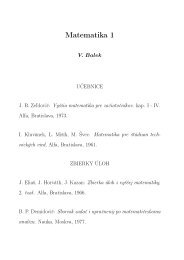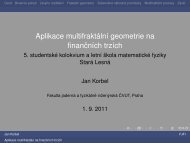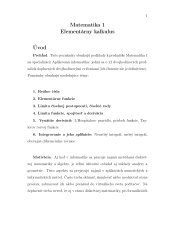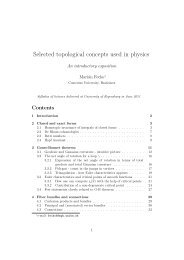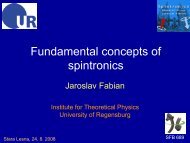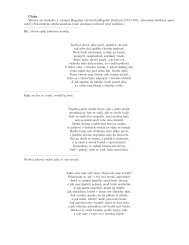Quantum Field Theory I
Quantum Field Theory I
Quantum Field Theory I
Create successful ePaper yourself
Turn your PDF publications into a flip-book with our unique Google optimized e-Paper software.
34 CHAPTER 1. INTRODUCTIONS<br />
Bloch theorem reveals the generic form of eigenfunctions of the Hamiltonian<br />
which is symmetric under the lattice translations. The eigenfunctions are<br />
labeled by two quantum numbers n and ⃗ k, the former (called the zone number)<br />
being discrete and the latter (called the quasi-momentum)being continuousand<br />
discrete for infinite and finite lattices respectively (for large finite lattice, the ⃗ k<br />
is so-called quasi-continuous). The theorem states that the eigenfunctions are<br />
of the form ϕ n, ⃗ k<br />
(⃗r) = e i⃗ k.⃗r u n, ⃗ k<br />
(⃗r), where the function u n, ⃗ k<br />
(⃗r) is periodic (with<br />
the periodicity of the lattice) 38 . In the solid state physics the theorem is supplemented<br />
by the following more or less plausible assumptions:<br />
• The theorem holds not only for the Schrödinger equation, but even for the<br />
Hartree and Hartree-Fock equations with periodic external potentials.<br />
• The energy ε n ( ⃗ k) is for any n a (quasi-)continuous function of ⃗ k.<br />
• The relation ε n ( ⃗ k) = const defines a surface in the ⃗ k-space.<br />
The very important picture of the zone structure of the electron states in<br />
solids results from these assumptions. So does the notion of the Fermi surface,<br />
one of the most crucial concepts of the solid state physic. In the ground<br />
state of the system of non-interacting fermions, all the one-fermion levels with<br />
energies below and above some boundary energy are occupied and empty respectively.<br />
The boundary energy is called the Fermi energy ε F and the surface<br />
corresponding to ε n ( ⃗ k) = ε F is called the Fermi surface.<br />
The reason for the enormous importance of the Fermi surface is that all<br />
the low excited states of the electron system lie in the vicinity of the Fermi<br />
surface. The geometry of the Fermi surface therefore determines a great deal of<br />
the physical properties of the given solid.<br />
Calculationofthe Fermi surfacefrom the first principlesis onlypossible with<br />
some (usually quite radical) simplifying assumptions. Surprisingly enough, yet<br />
the brutally looking simplifications use to give qualitatively and even quantitatively<br />
satisfactory description of many phenomena. However, the most reliable<br />
determinations of the Fermi surface are provided not by the theory, but rather<br />
by the experiment. There are several methods of experimental determination<br />
of the Fermi surface. The mutual consistency of the results obtained by various<br />
methods serves as a welcome cross-check of the whole scheme.<br />
38 The proof is quite simple. The symmetric Hamiltonian commutes with any translation<br />
T ⃗R where R ⃗ is a lattice vector. Moreover, any two translations commutes with each other.<br />
Let us consider common eigenfunctions ϕ(⃗r) of the set of mutually commuting operators<br />
presented by the Hamiltonian and the lattice translations. We denote by λ i the eigenvalues<br />
of the translations along the three primitive vectors of the lattice , i.e.T ⃗ai ϕ(⃗r) = λ i ϕ(⃗r). The<br />
composition rule for the translations (T ⃗A+ ⃗ B = T ⃗A T ⃗B ) implies T ⃗R ϕ(⃗r) = λ n 1<br />
1 λn 2<br />
2 λn 3<br />
3 ϕ(⃗r) for<br />
⃗R = ∑ 3<br />
i=1 n i⃗a i . On the other hand, T ⃗R ϕ(⃗r) = ϕ(⃗r + ⃗R). This requires |λ i | = 1, since<br />
otherwise the function ϕ(⃗r) would be unbounded or disobeying the Born-Karman periodic<br />
boundary conditions for the infinite and finite lattice respectively. Denoting λ i = e ik ia i (no<br />
summation) one has T ⃗R ϕ(⃗r) = e i⃗ k. ⃗R ϕ(⃗r). At this point one is practically finished, as it is now<br />
straightforward to demonstrate that u ⃗k (⃗r) = e −i⃗ k.⃗r ϕ(⃗r) is periodic. Indeed T ⃗R e −i⃗ k.⃗r ϕ(⃗r) =<br />
e −i⃗ k.(⃗r+ ⃗ R) ϕ(⃗r + ⃗ R) = e −i⃗ k.⃗r e −i⃗ k. ⃗R T ⃗R ϕ(⃗r) = e −i⃗ k.⃗r ϕ(⃗r).<br />
For an infinite lattice, ⃗ k can assume any value ( ⃗ k is a continuous). For finite lattice the<br />
allowed values are restricted by the boundary conditions to discrete possible values, nevertheless<br />
for large lattices the ⃗ k-variable turns out to be quasi-continuous (for any allowed value,<br />
the closest allowed value is ”very close”). For a given ⃗ k, the Hamiltonian can have several<br />
eigenfunctions and eigenvalues and so one needs another quantum number n in addition to<br />
the quantum number ⃗ k .


